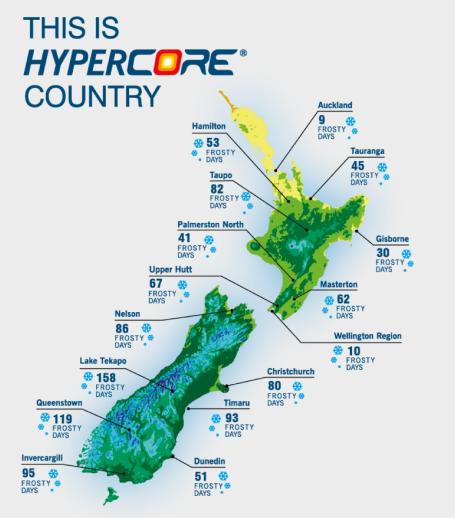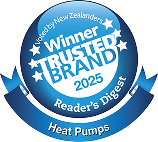Heat pump sizing and installation
Choosing the right sized heat pump is key to ensuring optimum comfort levels. Every home is as individual as its owner. The key to selecting the right heat pump for
heating your home is choosing the correct unit size for your location.
As such, Mitsubishi Electric recommends that a free in-home consultation and quote is always completed by an
authorised Mitsubishi Electric dealer before a system is actually purchased.
Insulation and building orientation are key factors which may influence the degree of heat loss in a home. An older style home with poor insulation will lose indoor heat much quicker than
a modern well insulated home that faces north. The quicker a home loses its heat, the bigger the heat pump system will need to be to overcome this heat loss.
Outdoor ambient conditions in winter also play a big role in unit size selection. When temperatures drop, the output capacity of the heat pump also drops. Areas of New Zealand that experience
sub-zero temperatures in winter (like most of the South Island) will require either a larger capacity heat pump in comparison to a same sized room in the Auckland region or
an upgrade to a HyperCore® Inverter High Performance Heat Pump.
Take the guess work out - use our sizing tool to select the best heat pump for you, based on your regions average lowest winter temperature.
It can then also direct you in booking your free in-home consultation.
Getting your heat pump installed, how does the process work?
1. Enquiry
Once you have completed our In Home Consultation Form a local Mitsubishi Electric Heat Pump expert will contact
you within 2 business days to arrange a consultation time that suits you.
2. Free Consultation
Your Mitsubishi Electric Dealer will visit your home to evaluate your needs.
Assessment of your home's temperature, size and design as well as room size, layout and orientation will allow them to recommend a heat pump that suits your unique requirements.
Your expert will then explain their recommendations, the installation process and leave you with a detailed quote.
3. Install
Once you are satisfied with your quote, your Mitsubishi Electric expert will arrange a suitable installation time with you.
Installation and a full series of tests will be completed to ensure your Mitsubishi Electric Heat Pump is working correctly.
Finally, your dealer will set up the heat pumps remote control to suit your needs and answer any questions you may have.
Energy efficiency at 2 degrees
H2 Ratings – what are they?
H2 ratings are a move towards assisting customers to make more informed decisions on their heat pump unit’s performance. As such, the “Voluntary H2” rating scheme has
been introduced by EECA. H2 rates heat pump heating performance outputs at 2°C outdoor ambient condition. This is a more real average condition for Southern Australia
and some mid and Southern New Zealand locations.
Heating capacity decreases when temperatures decrease
As the outdoor ambient temperature decreases below 7°C there is less available heat for an outdoor unit to recover. The ability of an outdoor unit to recover heat
in these low ambient conditions varies greatly between brands. Larger outdoor coil surface area, compressor size, defrost strategy all affect heat recovery capacities
at low ambient conditions.
Superior heat pumps will have a lineal capacity decrease as outdoor ambient conditions decrease. Many brands that are primarily designed for cooling have steep performance
curve degradation when ambient temperatures reach 0°C or below. Mitsubishi Electric publishes low ambient performance output and COP data in sizing and sales guides in
our Service Technical Manuals for your reference.
Colder climates need to be sized to H2 ratings to ensure optimum performance
Where ambient conditions are regularly lower than 7°C a design ambient condition should be selected and the low ambient performance guide used for the final unit selection.
For example in Timaru where ambient day and night time temperatures often reach 0°C or below the 2°C rating should be used as a minimum. For optimum comfort looking at rated output
between 0°C or –5°C will give the best results, ensuring that in low ambient conditions the heat pump will deliver performance that will reach set point and satisfy the end users expectations.
If 5.6kW of heating capacity is required to heat a room, a heat pump that is rated at 5.6kW heating will not deliver 5.6kW at 0°C outdoor ambient temperature!
Output at 0°C is likely to be 4.76kW. A 6.8kW heat pump however is likely to still provide 5.78kW of heating capacity at 0°C, as such would be the correct choice.
It is therefore extremely important that units are not undersized in low ambient conditions.
The other option is to upgrade to a HyperCore® Inverter High Performance Heat Pump that is guaranteed to provide the same amount
of heat at 7°C, 0°C, -7°C, in fact right down to -15°C.
Ground frost occurs when the air at ground level is chilled below freezing point.
This map shows just how many ground frost days there are right across New Zealand during winter. In these low temperature conditions the performance of normal
heat pumps would deteriorate, but advanced HyperCore Technology means you can rely on the Mitsubishi Electric HyperCore Range to keep you warm when you need it most.
The Mitsubishi Electric HyperCore Range includes the only heat pumps that guarantee this level of advanced performance.
Mean number of days per year of ground frost according to the NIWA website. Ground frost occurs when the air at ground level is chilled below freezing point.
Read more on HyperCore Technology
Other factors that can affect system performance
Indoor unit location
It is essential the indoor unit is located correctly to make sure the airflow in the heated space is effective. Many indoor units are mounted to close to the ceiling, this causes the unit
to short cycle and shut down prematurely. Locating the indoor unit in a corner of a room, across a hallway, or in areas where it will be subject to draughts from other rooms will
have adverse effects on performance. High walls units are designed to be located high on the wall as per the installation instructions not low on the wall as some installation companies
have been doing. “Low Wall” installations will not be covered by warranty, which is why we always recommend that an Authorised Mitsubishi Electric Installer is used.
Excessive pipe runs
Excessive pipe run lengths will limit unit output and can cause reduced compressor sub cooling and in certain cases compressor failure. Please respect manufacturers recommended pipe
run lengths. Please also remember excessive pipe bends can reduce unit performance by adding additional refrigerant internal friction losses.
Outdoor humidity
Outdoor humidity also affects heating performance. Areas that have a “dry cold” or low humidity such as Mount Cook will perform better at low ambient than say Taupo where
ambient conditions can reach zero and misty moisture laden air conditions exists. The more moisture in the air the more moisture will freeze on the outdoor coil.
Incorrect unit selection
If a unit is selected that is too small the heat pump will run continuously and never reach set point. This continuous running will increase defrost requirements by
reducing the outdoor coil running temperature and driving it into sub-zero temperatures for excessive periods. The unit will defrost at the minimum intervals and may
never catch up and achieve set point.
Location of outdoor unit
Location of the outdoor unit is essential for low ambient performance. Units located under houses, decking and in areas where airflow is impeded may create their
own microclimate and reduce the effective outdoor ambient temperature that the units operates in. Locating the outdoor unit too close to a wall and not observing
clearances will also prevent the unit from delivering full output.




